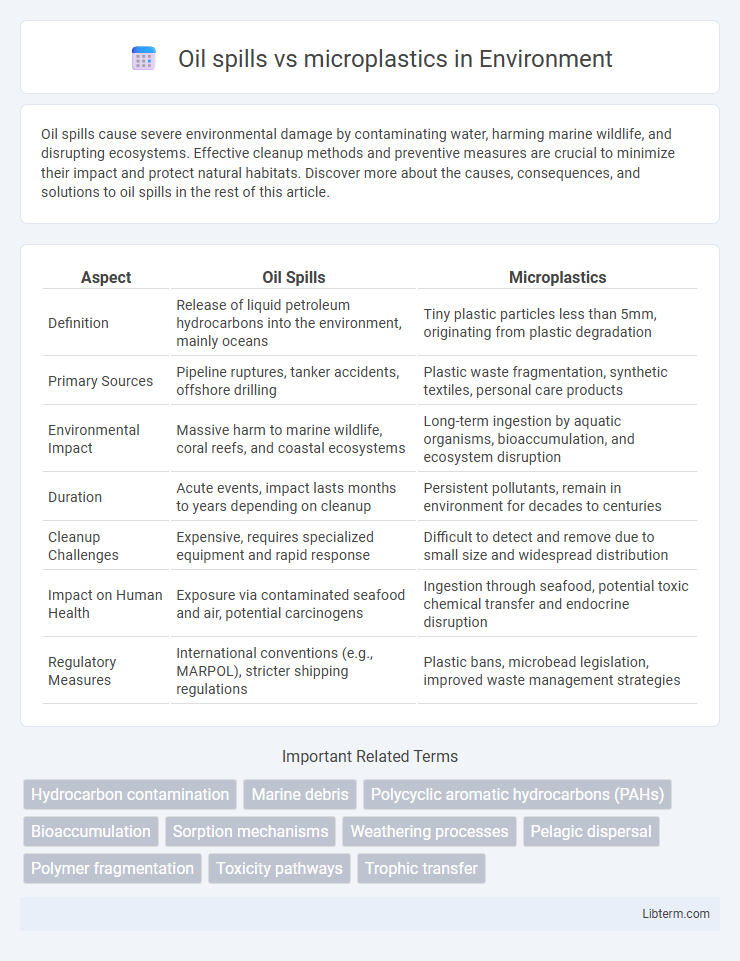Oil spills cause severe environmental damage by contaminating water, harming marine wildlife, and disrupting ecosystems. Effective cleanup methods and preventive measures are crucial to minimize their impact and protect natural habitats. Discover more about the causes, consequences, and solutions to oil spills in the rest of this article.
Table of Comparison
| Aspect | Oil Spills | Microplastics |
|---|---|---|
| Definition | Release of liquid petroleum hydrocarbons into the environment, mainly oceans | Tiny plastic particles less than 5mm, originating from plastic degradation |
| Primary Sources | Pipeline ruptures, tanker accidents, offshore drilling | Plastic waste fragmentation, synthetic textiles, personal care products |
| Environmental Impact | Massive harm to marine wildlife, coral reefs, and coastal ecosystems | Long-term ingestion by aquatic organisms, bioaccumulation, and ecosystem disruption |
| Duration | Acute events, impact lasts months to years depending on cleanup | Persistent pollutants, remain in environment for decades to centuries |
| Cleanup Challenges | Expensive, requires specialized equipment and rapid response | Difficult to detect and remove due to small size and widespread distribution |
| Impact on Human Health | Exposure via contaminated seafood and air, potential carcinogens | Ingestion through seafood, potential toxic chemical transfer and endocrine disruption |
| Regulatory Measures | International conventions (e.g., MARPOL), stricter shipping regulations | Plastic bans, microbead legislation, improved waste management strategies |
Understanding Oil Spills and Microplastics
Oil spills release vast amounts of crude oil into marine environments, causing toxic harm to marine life and ecosystems. Microplastics, tiny plastic particles less than 5mm in size, originate from degraded larger plastics and are pervasive pollutants affecting water quality and food chains. Both pollutants disrupt marine habitats but differ in composition, persistence, and ecological impact, making targeted mitigation strategies essential.
Sources and Causes: Oil Spills vs Microplastics
Oil spills originate mainly from offshore drilling accidents, tanker collisions, and pipeline ruptures, releasing large volumes of crude oil or refined petroleum into marine environments. Microplastics primarily result from the fragmentation of larger plastic debris, synthetic textile fibers, and microbeads found in personal care products. Both pollutants cause severe environmental damage, but while oil spills are episodic and point-source events, microplastics represent a pervasive, chronic pollution issue stemming from diverse terrestrial and aquatic sources.
Environmental Impact: Comparing Oil Spills and Microplastics
Oil spills cause immediate and severe damage to marine ecosystems by coating wildlife and disrupting habitats, leading to long-term toxicity and oxygen depletion in water bodies. Microplastics, although less visible, infiltrate food webs through ingestion by marine organisms, causing chronic health issues and bioaccumulation of harmful chemicals across trophic levels. Both pollutants significantly degrade oceanic environments but differ in their persistence, scale of impact, and mechanisms affecting biodiversity and water quality.
Effects on Marine Life and Ecosystems
Oil spills cause immediate and severe damage to marine life by coating organisms, disrupting respiratory functions, and poisoning habitats through toxic hydrocarbons. Microplastics persist in ecosystems, accumulating in the food chain and causing long-term health issues such as impaired reproduction and growth in marine species. Both pollutants alter ecosystem dynamics by reducing biodiversity and habitat quality, threatening the resilience of marine environments.
Human Health Risks of Oil Spills and Microplastics
Oil spills release toxic hydrocarbons such as benzene and polycyclic aromatic hydrocarbons (PAHs), which can cause respiratory problems, skin irritation, and long-term carcinogenic effects in humans. Microplastics contain harmful additives like phthalates and bisphenol A (BPA) that disrupt endocrine function and accumulate in the food chain, posing risks of hormonal imbalance and reproductive issues. Both contaminants contaminate seafood, increasing the risk of bioaccumulation of toxins and adverse health outcomes for coastal populations.
Detection and Monitoring Methods
Oil spills are detected using satellite remote sensing techniques such as Synthetic Aperture Radar (SAR) and multispectral imaging, which identify oil slicks on water surfaces by their distinct spectral signatures. Microplastics detection relies on spectroscopic methods like Fourier-Transform Infrared (FTIR) and Raman spectroscopy, combined with microscopy to characterize particle size, shape, and polymer type in environmental samples. Continuous monitoring integrates autonomous underwater vehicles (AUVs) equipped with sensors and machine learning algorithms for real-time data acquisition and precise contamination mapping.
Cleanup Technologies and Challenges
Oil spills demand rapid containment methods such as booms, skimmers, and chemical dispersants to mitigate environmental damage, yet these technologies face challenges including incomplete recovery, toxicity of dispersants, and sensitivity to weather conditions. Microplastics cleanup relies on advanced filtration systems, surface skimmers, and bio-absorption techniques, but their small size, widespread distribution, and interaction with marine life complicate effective removal. Both pollution types require continuous innovation in remediation technology and integrated monitoring to address persistent contamination and ecological impact.
Policy Responses and Regulations
Policy responses to oil spills prioritize rapid containment and cleanup through strict liability laws and mandatory reporting protocols, such as the U.S. Oil Pollution Act of 1990, which enforces financial responsibility from polluters. Regulations concerning microplastics emphasize prevention through bans on microbeads in cosmetics and restrictions on plastic pellet handling under the Microbead-Free Waters Act and international marine pollution treaties like MARPOL Annex V. Both policy frameworks increasingly integrate environmental monitoring, enforcement mechanisms, and cross-border cooperation to mitigate ecological damage and promote sustainable ocean management.
Prevention Strategies: Oil vs Plastic Pollution
Effective prevention strategies for oil spills emphasize rigorous pipeline inspections, improved vessel maintenance, and the use of double-hulled tankers to minimize accidental discharges. In contrast, combating microplastic pollution requires reducing plastic production, enhancing waste management systems, and promoting biodegradable alternatives to limit environmental contamination. Both approaches benefit from stringent regulatory frameworks and public awareness campaigns to reduce hazards in marine ecosystems.
Future Outlook: Solutions and Innovations
Emerging technologies in bioremediation use genetically engineered microbes to break down oil spills faster and more efficiently, reducing environmental damage. Advanced filtration systems and nanomaterials are being developed to capture microplastics in water bodies before they accumulate in marine ecosystems. Ongoing research emphasizes integrating AI-driven monitoring to predict spill events and microplastic pollution hotspots, enabling proactive responses and sustainable ocean management.
Oil spills Infographic

 libterm.com
libterm.com